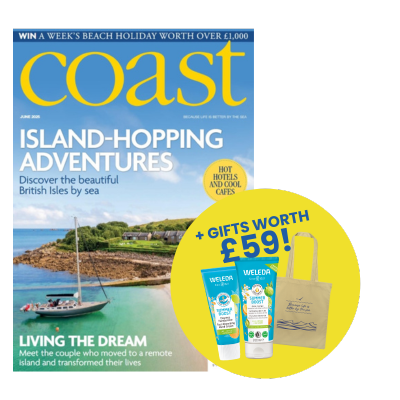Famed for its sublime native oysters, Whitstable also offers handsome streetscapes, independent shops and art galleries and compelling wildlife, making for an idyllic weekend escape, writes KERRY SPENCER.
Lying on Kent’s sweeping north coast, on the edge of the nature-filled Swale Estuary, oysters have long been savoured in Whitstable, collected from low-tide beds since Roman times. There’s plenty more to this bohemian pocket of the southeast than its briny oysters, as delicious as they are.
We’re also here to shop, relax and uncover some of the region’s rich natural landscape. And, yes, indulge in some of Whitstable’s outrageously good seafood, too.
Top of our list is the Whitstable Coastal Trail, unfurling around 5km from the Second World War tank traps in the west to Swalecliffe in the east. Whitstable town centre lies somewhere in the middle with most of the route wheelchair accessible, bar the final western stretch. We guzzle up the salty sea air on a blissfully cloud-free day from outside of our base, the Marine Hotel, at Tankerton Beach.
We stroll west, towards Whitstable town centre, spotting Maunsell Forts on the horizon. Built a few miles offshore in the Thames Estuary as defensive forts during the Second World War, these concrete and steel towers cast a haunting silhouette. There’s an ice-cream parlour on the beach and a row of macaron-coloured beach huts with plenty of space for bathing and refreshing sea swims. Continuing towards the centre of Whitstable, we pass The Street at around the halfway mark. At low tide, this wide gravel ridge on the seabed is exposed, unfolding around 1km into Whitstable Bay.
HERITAGE HARBOUR
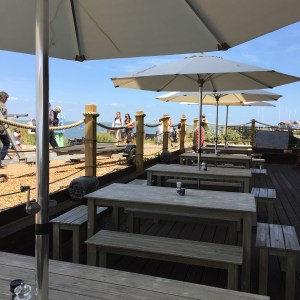
By now we’ve earned lunch, which is at The Lobster Shack in East Quay on the more industrial end of Whitstable Harbour. It’s the former base of the Seasalter and Ham Oyster Fishery Company, directly facing the oyster beds. We arrive just in time to catch a live music session, with a daily roster of artists performing usually around lunchtime.
Owned by the Whitstable Oyster Company Ltd., The Lobster Shack serves its own oysters and brews, including the velvety Whitstable Brewery Oyster Stout. We dine on chunky cod in a crunchy batter with chips, a lobster and prawn roll and, naturally, a round of shimmering Whitstable native oysters drizzled in a zingy shallot vinaigrette.
Outside The Lobster Shack, we stretch our legs on the seafront, feeling the crunch of some of the thousands of oyster shells underfoot. At low tide, visitors can also peer at the oyster beds from the end of the quay. The Lobster Shack doesn’t accept reservations so arrive early for a table, especially during summertime when you’ll want to snag a spot outside at the beach bar. (www.thelobstershack.co.uk)
Despite Whitstable being an important fishing hub for centuries, the harbour wasn’t built until the 1830s. Today, Whitstable Harbour is a fishing port and place to eat, drink and shop. We walk around the narrow U-shaped harbour by Starvation Point — a memorial dedicated to mariners lost at sea — to browse the stalls at Harbour Market Whitstable, open Thursday to Monday. The market is a lovely spot to shop for local crafts and seaside necessities, including silver and pearl jewellery, driftwood-carved homeware and nautical-themed artwork. There are several food stalls here, too, offering everything from fragrant Thai dishes to fresh-off-the-boat seafood. (www.harbourmarketwhitstable.co.uk)
CREATIVE BUZZ
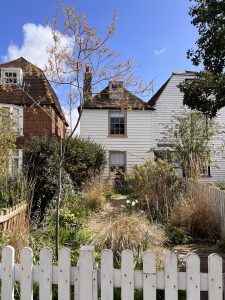
In the afternoon, we were keen to explore Whitstable’s buzzy creative side and see more of the town’s postcard-pretty clapboard houses. Working our way from the seafront, we wander to Sea Wall and Seal Street, each offering a mashup of clapboard-cladded homes and pretty cottages, treating ourselves to a creamy cone at Sea Wall’s gelateria.
We stop by The Horsebridge, a multifunctional space with an art gallery, film showings, artist talks and classes throughout the year. The focus here is the local community and social impact, so you might find projects such as the recent Waste Line exhibition that explored the impact we have on our coastal landscape and environment.
From street art by local artist Catman to the many galleries, restaurants and independent shops, High Street and Oxford Street (one leads to the other) are a joy to explore. We walk by the famous Wheelers Oyster Bar, known as much for its glorious pink façade as it is for its decadent seafood.
We don’t need to stock up on fresh supplies during our stay, however, if we did, we’d go straight to Granny Smiths greengrocer (91 High St) and Jim’s Family Butchers (99-101 High St). We do however refuel on coffee at Grain & Hearth Bakery (52 Oxford St), which lures customers in with rows of plump sourdough in the window.
We admire Bruce Williams’ Art Studio (66 High St) filled with a captivating collection of seascapes and still lifes. Then it’s over to Whitstable Community Museum & Gallery (5a Oxford St), a wonderful time capsule of the town. The museum explores areas such as fishing, shipbuilding, oysters and shipwrecks. If you’re a railway buff, you’ll love the Invicta locomotive. It’s one of the oldest in the world.
There’s some fascinating antique diving equipment — with the world’s first diving helmet developed in Whitstable by brothers Charles and John Dean between 1825 and 1830. Peter Cushing is represented, too, with the famous British actor residing on Island Wall for 35 years during a period when he starred in many famous Hammer horror movies. (www.whitstablemuseum.org)
We spot other references to the stoic star around town, including The Peter Cushing pub, located in a converted Art Deco cinema, also on Oxford Street.
SHOPPING & SUPPER
Next, we make a beeline for Valentines Vintage (21 Oxford St), a treasure trove of mid-century furniture and decorative items, picking up a 1970s desk lamp. Continuing to the mood-lifting Chappell Contemporary art gallery (30 Oxford St), we pore over pieces by Kristjana S Williams and Emma Gibbons and admire the homeware at Scandinavian Touch (66 Oxford St). We also love Blueprint Coffee (4 Oxford St), not only for its flat whites and fresh bakes, but the store doubles up as a cute bookshop.
From Samphire to Farm & Harper, there is an abundance of restaurants on this central strip. We couldn’t miss the chance to try the long-standing Wheelers, opened in 1856 by Richard Leggy Wheeler. Supper is a leisurely affair of grilled scallops with buttered Kentish asparagus, sticky Korean prawns and pan-fried crab cake. On Friday and Saturday evenings there’s also a £70 per head seven-course tasting menu. (www.wheelersoysterbar.com) To finish our day, we head for the Old Neptune, a chalk-white clapboard Victorian inn on Marine Terrace — catching Whitstable at its finest hour, as the sun slowly melts into the glittering bay, from a bench outside. (www.thepubonthebeach.co.uk)
COASTAL BOUNTY
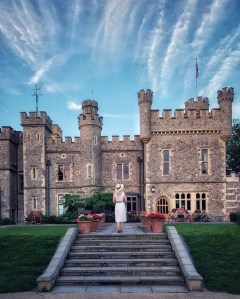
After a hearty breakfast at our sea-facing digs, we begin our day with a slow-paced wander around Whitstable Castle & Gardens. Built between 1790 and 1840, the castle is surrounded by gorgeous mature greenery, stationed in an elevated position on Tower Hill. Castle tours are free, though donations are welcome, led by volunteer guides at weekends only. The gardens are open daily and also free to explore. (www.whitstablecastle.co.uk)
After a warming cup of tea at the castle’s tea rooms, it was time to head back to the seafront. When exploring a new destination, we always look for more offbeat tours, which is how we discovered Amy Hitchcock of Forth and Forage. Amy runs private and group foraging tours of the Kent coast, where wild herbs, sea vegetables and edible flowers are among the bounty of coastal produce available, including rare hog’s fennel and three-cornered leek.
A tour takes us to the Tankerton Slopes on Marine Parade, where we pick clumps of edible flowering alexanders, before continuing to the harbour. £10-£20 for adults, £5 for teens and under 12s go free. (www.forthandforage.co.uk)
Next, we enjoy lunch of Pork & Co’s pulled pork rolls with homemade slaw at Whitstable Harbour Market, before joining a seal-spotting expedition to South Swale Nature Reserve. The exhilarating one-hour journey with Whitstable Boat Trips (www.whitstableboattrips.co.uk) whisks us from the harbour towards the marshy banks of The Swale in search of languid grey and common seals.
Under cotton skies, we slow to see a small cluster of these adorable, protected creatures from a safe distance. We notice some have a distinct coppery hue, a result of the iron oxide-rich clay soil. Other wildlife thrives here, too, including a number of bird species, such as reed warbler, breeding redshank and skylark, while sea-lavender, golden samphire and sea-purslane make for a vibrant display on the shore. £30 adults; £20 children.
WINE COUNTRY
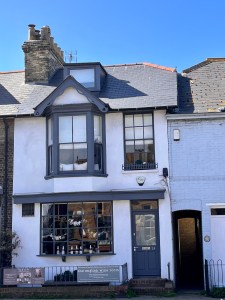
Following a day of nature exploration, we make it our mission to imbibe on some of the delicious wines produced here in Kent, with over 50 vineyards scattered across the Garden of England. The English Wine Room (24 Oxford St) offers tastings of local wines, such as Barnsole’s Rosé de Noir, a creamy Kent sparkling wine with just a hint of strawberries. Led by owner Susie Frank, a tasting session lasts for two hours with eight wines presented from Kent vineyards. £50 per person for groups of 10-14, with regular dates availability for individuals and smaller groups. (www.englishwineroom.com)
For dinner, we opted for Birdies (www.birdiesrestaurant.co.uk), a charming French restaurant on Harbour Street that’s been in the Colthup family since 1993. With a menu that plays on local seafood, we plump for Moules Mariniere to share followed by fried skate wing with a lobster butter and Dover Sole Meuniere, washed down with a bottle of Sancerre. The food was divine and a wonderful end to our weekend in Whitstable.
To plan a trip to Whitstable and the wider Kent region, visit www.visitkent.co.uk.
DELECTABLE DINING
From vinegar-soaked fish and chips to Michelin-star cuisine, visitors to Whitstable are met with a sensational dining scene. The Sportsman in Seasalter, on the outskirts of Whitstable, is a must-visit for its locavore five-course tasting menu that is tweaked daily to reflect the ever-changing freshest local produce. The £80 menu is worth every penny, with ludicrously tasty dishes such as the poached rock oysters, pickled cucumber and Avruga caviar and roast John Dory with Bouillabaisse and green olive tapenade. (www.thesportsmanseasalter.co.uk)
The Whitstable Oyster Company is a failsafe option on Whitstable seafront to relish rich and creamy Rock oysters, from £14. Try the pan-fried razor clams with garlic butter, £14, too. You won’t regret it. (www.whitstableoystercompany.com)
For takeaway fried cod, chips and mushy peas, £13.50, go for Harbour Street’s V. C. Jones chippie, eaten on the beach. (www.vcjones.co.uk)
WHERE TO STAY
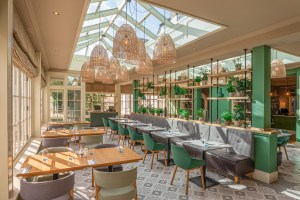
I was a guest of The Marine Hotel, which is ideally situated facing the wide-open Marine Parade. This soul-soothing spot is close to the town centre and a stone’s throw from the shingle Tankerton Beach. There are 30 bedrooms, 20 with sea views and some with balconies. Rooms feature muted, calming colours with a beautiful balance of traditional seaside charm and contemporary finishes, such as photographic art and plush upholstery.
There’s a restaurant and bar for breakfast, afternoon tea and dinner. Guests can take a seat outside and enjoy a glass of crisp Kentish wine or enjoy everything from a bacon and fried egg brioche roll to oysters, crab linguine and ale battered cod and chips inside the restaurant. There’s a kid’s menu, and vegan and vegetarian options are available. Travelling with your furry friend? Request one of The Marine Hotel’s dog-friendly rooms. Doubles from £120 a night. (www.marinewhitstable.co.uk)







